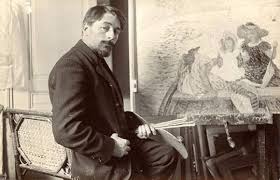(1865-1937)
Henri Lebasque was born in 1865 in Champigne, France. In 1885 he started his education at the Ecolé des Beaux-Arts d’Angers, and moved to Paris in 1886. There, Lebasque entered the studio of artist Léon Bonnat, and assisted Humbertwith the decorative murals at the Panthéon.
In 1893, Henri Lebasque had his first exhibition at the Salon des Independents, where he met Paul Signac and Maximilien Luce. Lebasque’s vision was colored by his contact with younger painters, especially Edouard Vuillard and Pierre Bonnard, founders of the The Nabis’ Group, who were the Intimists that first favored the calm and quietude of domestic subject matter. From his first acquaintance with George s Seurat and Paul Signac, Lebasque learned the significance of a color theory which stressed the use of complementary colors in shading. Within the following year he met Camille Pissarro and August Renoir, he began to visit Camille Pissarro’s house on the outskirts of Paris. Pissarro was one of the first to recognize Lebasque’s talents in 1903, praising it at the Salon des Independents.
That year, the Salon d’Automne was founded, and Lebasque became one of its founding members along with his friend Henri Matisse. Two years later, a group of artists exhibited there which included Georges Rouault, André Derain, Edouard Vuillard, and Matisse. Throughout this period of time, Lebasque also became friends with artists such as Gustave Rouault, Raoul Dufy, Louis Valtat, and Henri Manguin, it was he, who suggested to Lebasque that he move his family to the South of France (Le Midi).
Once in that region of strong sunlight and bright colors, he became enamored of the Fauve artists, Henri Matisse, Raoul Dufy and Louis Valtat and his bright canvases reflect their influence. In Le Cannet, he befriended Pierre Bonnard, and the two artists shared the same models. During this period, Lebasque focused on the nude as subject and was successful in capturing the natural nonchalance of his models positioned upon wonderfully patterned fabrics. Painting during the Post-Impressionist period, Henri Lebasque exhibited for thirty years at the Salon d’Automne and Salon des Independents with artist friends Maximilien Luce, Paul Signac and Henri Manguin. He is known as a “painter of the good life” because his works depict members of his family at home, in gardens, on terraces and by the seashore. These scenes of daily life are imbued with a quiet innocence and painted in a spontaneous yet well-composed manner.
After a rich and rewarding life, Henri Lebasque died at his home in Le Cannet, Alpes- Maritimes, in 1937. Twenty years after his death, the Musée des Ponchettes in Nice presented the first retrospective of the works of Henri Lebasque
Museums:
Fogg Art Museum, Harvard University, Cambridge
Detroit Institute of Arts
Nelson-Atkins Museum, Kansas City
Indianapolis Museum of Art
Lyman Allyn Museum, New London
The Fine Arts Museums of San Francisco
Bridgestone Museum, Toyko
Musee de Petit Palais, Geneva
Musee d’Angers
Musee des Beaux-Arts, Canne
Musee des Peintures et Sculptures, Grenoble
Musee des Beaux-Arts, Lyon
Musee des Beaux-Arts, Nantes
Musee des Beaux-Arts Jules Cheret, Nice
Musee d’Orsay, Paris
Musee de l’Annonciade, St. Tropez
Musee des Beaux-Arts, Strasbourg

